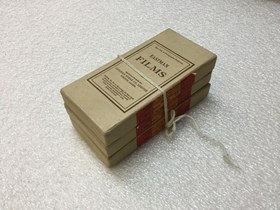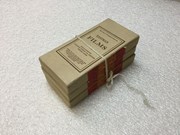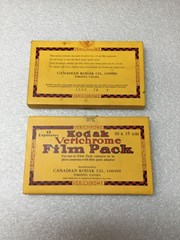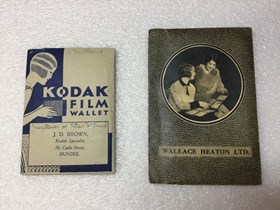Narrow Results By
- Date
- 1930 – 1939
- Material
- paper; string;
- Catalogue Number
- 104.41.0208 a-c
- Description
- Three paper-wrapped packages of a dozen 1 11/16 x 4 3/16 cm Eastman Nitrate Films stacked and tied together with white string. Each box has a red and orange sticker on one side with details pertaining to the number, size, and kind of films inside [as well as a warning about keeping them away from h…
1 image
- Title
- Film
- Date
- 1930 – 1939
- Material
- paper; string;
- Dimensions
- 4.6 x 6.0 x 12.1 cm
- Description
- Three paper-wrapped packages of a dozen 1 11/16 x 4 3/16 cm Eastman Nitrate Films stacked and tied together with white string. Each box has a red and orange sticker on one side with details pertaining to the number, size, and kind of films inside [as well as a warning about keeping them away from heat and flames], and on the opposite side have black stamps that read “DEVELOP BEFORE JUNE 1939.” Printed on the top of the top-most box is the manufacturer’s details.
- Credit
- Gift of Robert Crosby Family, Banff, 1998
- Catalogue Number
- 104.41.0208 a-c
Images
This material is presented as originally created; it may contain outdated cultural descriptions and
potentially offensive content.
Read more.
- Date
- 1930 – 1960
- Material
- cardboard; metal;
- Catalogue Number
- 110.01.0294 a-c
- Description
- Three empty boxes for 16 mm Cine-Kodak Kodachrome and Panchromatic Safety Films. Two boxes have the empty metal film reels inside. The exteriors of the boxes are covered in product and manufacturer details and, on the back, are shipping details for when the film has been developed - two are address…
1 image
- Title
- Film Box
- Date
- 1930 – 1960
- Material
- cardboard; metal;
- Dimensions
- 2.7 x 9.8 x 9.8 cm
- Description
- Three empty boxes for 16 mm Cine-Kodak Kodachrome and Panchromatic Safety Films. Two boxes have the empty metal film reels inside. The exteriors of the boxes are covered in product and manufacturer details and, on the back, are shipping details for when the film has been developed - two are addressed from Peter Whyte in Banff and one is addressed from “MRS PETER WHYTE” in Concord.
- Credit
- Gift of Catharine Robb Whyte, O. C., Banff, 1979
- Catalogue Number
- 110.01.0294 a-c
Images
This material is presented as originally created; it may contain outdated cultural descriptions and
potentially offensive content.
Read more.
- Date
- 1930 – 1980
- Material
- leather; metal; wood; paper
- Catalogue Number
- 104.41.0093 a-h
- Description
- Hard-sided black carry case with a hinged lid and unlined wooden interior. All corners are capped with metal, mostly rusted - three metal latches are also extensively rusted (the centre one is a lock latch). Running along the length of the lid and the bottom of the case are two parallel wooden runn…
1 image
- Title
- Film Case
- Date
- 1930 – 1980
- Material
- leather; metal; wood; paper
- Dimensions
- 22.3 x 21.2 x 62.4 cm
- Description
- Hard-sided black carry case with a hinged lid and unlined wooden interior. All corners are capped with metal, mostly rusted - three metal latches are also extensively rusted (the centre one is a lock latch). Running along the length of the lid and the bottom of the case are two parallel wooden runners. Also on the lid is a hard leather handle attached to the lid with metal loops - attached to both handle loops are several remnants of paper tags and a leather travel tag with a clear plastic window. Visible through the window is a stained paper tag that reads “N Morant Special Photographer Public Relations and Advertising Canadian Pacific Banff, Alberta.” Inside the lid is a “NATIONAL FILM BOARD OF CANADA Exposed Negative” card depicting a woman in a pale green bikini. Drawn on the inside of the lid in black, yellow, and red is a caricature of a face with a thought bubble that reads “AUNT MARTHA LIKES THIS ONE.” The exterior of the case is covered in faded and torn travel stickers and labels, there is also “D7” spray painted in yellow on the lid under the handle, on both short sides, and on the back. Inside the case are three black “KODAK HARD RUBBER TANK 4x5” containers. In one tank are two cardboard boxes - one is green and contains an Eastman timer and the other is a yellow “EASTMAN THERMOMETER” box with the thermometer inside. The second tank contains two circular metal supports for developing rolls of film negatives, a white metal Kodak film canister (empty), and a blue cardboard box with another metal film processor inside. The third tank contains a cylindrical container that has something inside of it, but it does not open.
- Credit
- Gift of Nicholas Morant, Banff, 2006
- Catalogue Number
- 104.41.0093 a-h
Images
This material is presented as originally created; it may contain outdated cultural descriptions and
potentially offensive content.
Read more.
- Date
- 1930 – 1959
- Material
- leather; metal; fabric; wood
- Catalogue Number
- 104.41.0082 a-c
- Description
- Metal developing tanks dimensions: 13.6x11.6x17.2 or smaller.Torn and crinkled label free-floating inside case reads “DALLON SS TANKS 3 1/4 X 4 1/4 24 CAPACITY.” DALLON most likely refers to David Allan (Dallan) sheet metal workers, specializing in darkroom products, of London England. Case is a ha…
1 image
- Title
- Film Developer
- Date
- 1930 – 1959
- Material
- leather; metal; fabric; wood
- Dimensions
- 16.0 x 17.5 x 30.0 cm
- Description
- Metal developing tanks dimensions: 13.6x11.6x17.2 or smaller.Torn and crinkled label free-floating inside case reads “DALLON SS TANKS 3 1/4 X 4 1/4 24 CAPACITY.” DALLON most likely refers to David Allan (Dallan) sheet metal workers, specializing in darkroom products, of London England. Case is a hard-sided black leather box with a lid that hinges open and held open with a brown leather strip on the left-hand side - also has silver metal clasps and carry handle on the front of the case. The case’s interior is lined with grey fabric and the main compartment is divided into two equal sections that house the metal developing tanks. Nailed to the bottoms of each compartment are pieces of wood to prevent the tanks from sliding around. The metal tanks have lids that lift off - one has notches that could have been used to latch the lid down, but no latches remain, and the other has holes in the middle of the lid from where a handle used to be, the handle is missing. Inside the tanks are cradles with lifting handles at either end and removable curved brackets to mount the film in. One tank has what appears to be a vent with a cap on one end, the cap appears to be stuck in place. Folded-up newspaper packed into empty spaces of case beside the tanks, removed.
- Credit
- Gift of Nicholas Morant, Banff, 2006
- Catalogue Number
- 104.41.0082 a-c
Images
This material is presented as originally created; it may contain outdated cultural descriptions and
potentially offensive content.
Read more.
- Date
- 1938 – 1945
- Material
- cardboard;
- Catalogue Number
- 104.41.0204 a,b
- Description
- Two boxes of 12 10x15cm Kodak Verichrome Film Packs with broken seals. Each box is mostly yellow with black and red manufacturer and product details throughout - there are two paper adhesive stickers holding the box closed, the one that has the expiration date on it on each box is broken.Verichrome…
1 image
- Title
- Film Pack
- Date
- 1938 – 1945
- Material
- cardboard;
- Dimensions
- 1.4 x 17.9 x 10.9 cm
- Description
- Two boxes of 12 10x15cm Kodak Verichrome Film Packs with broken seals. Each box is mostly yellow with black and red manufacturer and product details throughout - there are two paper adhesive stickers holding the box closed, the one that has the expiration date on it on each box is broken.Verichrome was a kind of panchromatic film that yielded high-quality black and white photographs thanks to the fine-grained emulsion. Film Packs were basic forms of storage meant to be used shortly after purchasing as their [mostly] paper packaging did not keep out oxygen well and had a tendency to fog over time, rendering the film unusable in the long term. It was replaced by the more stable Verichrome Pan in the 1950s.
- Credit
- Gift of Robert Crosby Family, Banff, 1998
- Catalogue Number
- 104.41.0204 a,b
Images
This material is presented as originally created; it may contain outdated cultural descriptions and
potentially offensive content.
Read more.
Film Projector
https://archives.whyte.org/en/permalink/artifact105.05.0041
- Date
- c. 1939
- Material
- metal; plastic; leather; paper; glass; wood
- Catalogue Number
- 105.05.0041
- Description
- A large, heavy 16mm Cine Projector incased within a black leather case, missing the reel arms and reels. The case features a lid with a black covered wood handle and two latches on the slimmer ends. Once unattached the interior of lid features a black cardboard label with white writing that reads “…
1 image
- Title
- Film Projector
- Date
- c. 1939
- Material
- metal; plastic; leather; paper; glass; wood
- Dimensions
- 35.2 x 23.6 x 38.8 cm
- Description
- A large, heavy 16mm Cine Projector incased within a black leather case, missing the reel arms and reels. The case features a lid with a black covered wood handle and two latches on the slimmer ends. Once unattached the interior of lid features a black cardboard label with white writing that reads “The Sole Canadian Distributor of this VICTOR SOUND ON FILM PROJECTOR is GENERAL FILMS LIMITED” then a horizontal list of Canadian cities of where offices are, where one would be able to get minor repairs and adjustment or service. Underneath the lid, the projector remains mostly concealed with a few cut-outs in the top where we can see parts of the projector such as the lights, a space where the reel arms would attach, the top of the fan, and another latch in the middle. Once the latch is open the one side of the case folds out. Once this is open the main body of the projector is revealed. There is various switches, projector lens, the track for the film reel, and the animatophone (for sound). Along the body of the projector fan is a metal label with gold writing and border, on the top is the Victor Logo ( a circle with a scroll above it), the text underneath reads “16mm CINE’ PROJECTOR”, in fine text “FOR USE WITH SLOW-BURNING ONLY”, in slightly larger text “Made in U.S.A. by VICTOR ANIMATOGRAPH CORPORATION DAVENPORT, IOWA”, “100 TO 120 VOLTS”, a gold rectangle stamped with “950” “WATTS”, “SERIAL NUMBER”, a gold rectangle stamped “116230”, “LAMP WATTAGE”, a gold rectangle stamped “750” “MAX.”, “MODEL”, and a gold rectangle stamped “40”. The three switches read “OFF REWIND”, “OFF PROJECT”, and “SILENT SPEED SOUND SPEED”. On the slimmer ends of the case, there are cut-outs for access to controls and plug-ins. The side where the projection would project has one spot for “P.E.C. VOLTAGE”, a knob for the “MICROPHONE”, a plug-in for “MICROPHONE”, and another plug-in for “PHONO”. On the opposite end, is a switch “OFF EXCITER”, two knobs “VOLUME” and “TONE”, a small protruding box with indecipherable text, a circular power cord to be plugged in, and two slots. Inside the case, is three pieces of instructional papers. One is an operation and care of manual, another a maintenance record template and information, and an operating instructions for the projector.
- Credit
- Gift of Dan MacDonald, Calgary, 1993
- Catalogue Number
- 105.05.0041
Images
This material is presented as originally created; it may contain outdated cultural descriptions and
potentially offensive content.
Read more.
- Date
- 1930 – 1931
- Material
- paper;
- Catalogue Number
- 104.41.0219 a,b
- Description
- Two paper folding envelopes for holding film and/or developed prints - one is Kodak and one is from Wallace Heaton Ltd., a developing studio in London England. Both wallets fold open to show two open-sided pouches where either films or prints could be slotted and have advertising for other services…
1 image
- Title
- Film Wallet
- Date
- 1930 – 1931
- Material
- paper;
- Dimensions
- 0.3 x 11.3 x 16.7 cm
- Description
- Two paper folding envelopes for holding film and/or developed prints - one is Kodak and one is from Wallace Heaton Ltd., a developing studio in London England. Both wallets fold open to show two open-sided pouches where either films or prints could be slotted and have advertising for other services/products printed on them. The Kodak wallet is predominantly white and blue, has a small slip of paper that appears to have “13/5/30 [?] Winton” and several numbers written on it in pencil, several numbers written in pencil on the left-hand side inside, and “Scotland / Negatives of Pete’s Scotland” written in black ink by Catharine Whyte on the front cover. The Wallace Heaton wallet is predominantly grey and black with a picture of two women looking at a photo album on the front cover, a slip of paper that appears to be a receipt for the Browns Hotel made out to “Nice Esq” tucking inside, “Scotland / Nice Esq / egative Scotland 1930” written in different hands on the back [everything except “Nice Esq” written by Catharine Whyte].
- Credit
- Gift of Catharine Robb Whyte, O. C., Banff, 1979
- Catalogue Number
- 104.41.0219 a,b
Images
This material is presented as originally created; it may contain outdated cultural descriptions and
potentially offensive content.
Read more.














